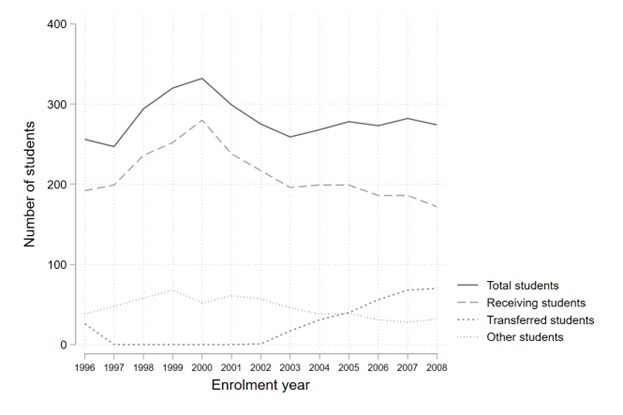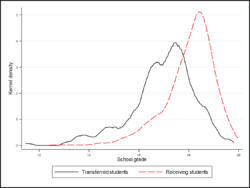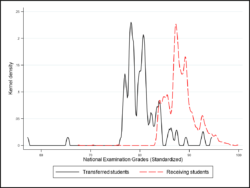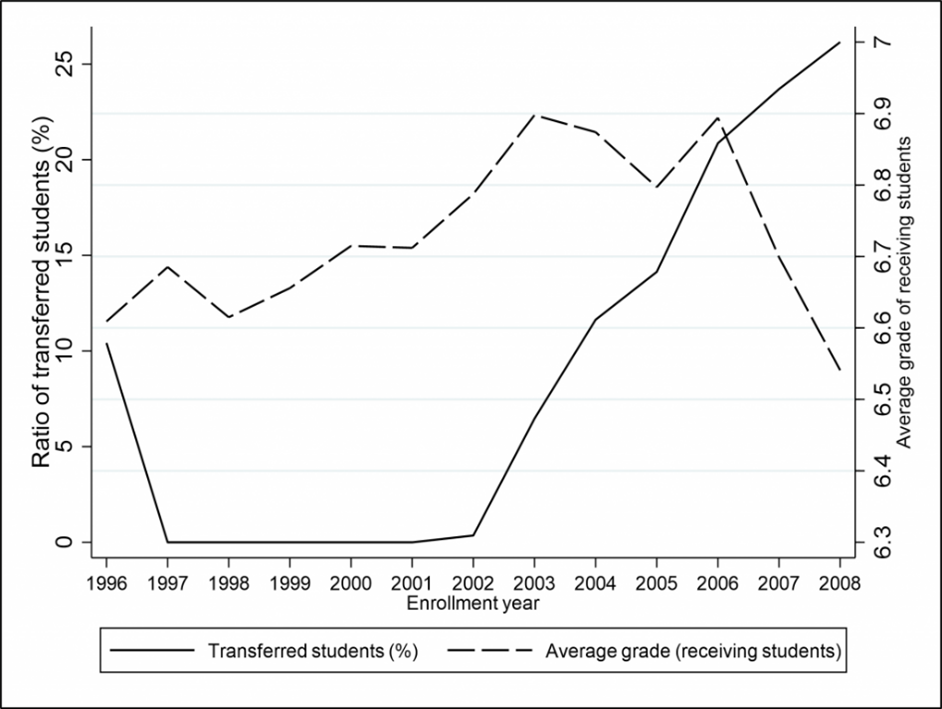- Education is often used as a (non-cash) welfare policy tool, particularly through mobility programs.
- We examine one such case, where students from large and financially strained families, were given the opportunity to be transferred to university departments in their hometown as part of the social policy of the Ministry of Education in Greece. The policy purpose is to help financially those families to pool their resources, by not needing to maintain a second household in a different city.
- However, transferred students are of lower academic quality than receiving students, thus raising the possibility of exerting a negative externality on their receiving peers.
- Multiple law changes meant that there was a large and quasi-random variability in the number of transferred students over time, which was unrelated to the quality of receiving students.
- We construct a novel dataset by linking students’ characteristics and pre-university academic performance with their university academic record until graduation for the top economics department.
- We provide consistent evidence that a social program intended to aid low-income families and reduce inequality has had a negative educational impact by uniformly lowering recipient students’ academic performance.
- We propose that policymakers could leverage these results to try to alleviate the negative externality by putting a strict cap (maximum 5%) on the number of transferred students and by requiring transferred students to take remedial courses (in our case it would be in mathematics and statistics) before formally joining their new departments.
Read here in pdf the Policy paper by Christos Genakos, Cambridge Judge Business School, University of Cambridge, Associate Researcher, Centre for Economic Performance (CEP), London School of Economics; Research Fellow, Centre for Economic Policy Research (CEPR) and Eleni Kyrkopoulou, Department of Economics, University of Piraeus.
Introduction
Education policies have been used to help social mobility and to address inequality of opportunities. […] However, often times such educational mobility policies are designed ignoring possible peer externalities. In this paper, we analyse one such striking example, where university access is used as a social policy to help large and financially constrained families.
Education, with its multifaceted role, is a key social policy instrument. Education policies have been used to help social mobility and to address inequality of opportunities by mixing students from various socioeconomic backgrounds in publicly-funded schools, by allowing school choice, or through specific policies, such as affirmative action in university admissions, or desegregation programmes in schools. Such policies are strongly predicated upon the assumption of significant positive peer effects. At the same time, education has also been used as a (non-cash) welfare policy tool, especially through mobility programmes. For example, the EU has instituted the European Credit Transfer and Accumulation System that helps students to move between countries and to have their academic qualifications and study periods abroad recognized, but also the Erasmus programme[1], a hugely popular student exchange programme across EU academic institutions. However, often times such educational mobility policies are designed ignoring possible peer externalities. In this paper, we analyse one such striking example, where university access is used as a social policy to help large and financially constrained families.
…transferred students are of lower academic quality than receiving students, thus raising the possibility of exerting a negative externality on their receiving peers.
To gain university entry, students in Greece participate in a national examination system. Based on their grades and their declared preferences, students get allocated to different universities and departments. After this allocation, the Ministry of Education operates a special transfer system, as part of its social policy, to assist large and financially constrained families. This policy is giving students from such families the opportunity to “transfer” to a similar subject university department in (or near) their hometown, in case they had successfully gained entry to a university department far from home. The policy purpose is to help financially those families to pool their resources, by not needing to maintain a second household in a different city. However, transferred students are of lower academic quality than receiving students, thus raising the possibility of exerting a negative externality on their receiving peers. Various changes in the relevant legislation meant that there was a large, quasi-random, variability in the number of transferred students over time, creating serious problems both at the leaving and at the receiving departments. Yet, despite the importance of this policy and the resulting highly inefficient redistribution of students, there is no systematic study of the effects of this policy.
Overall, our research shows how a social policy that is meant to help financially constrained families and to alleviate inequalities has gone bad educationally, by lowering the academic achievements of receiving students.
We present the first systematic examination of transferred university students’ impact on the academic performance of students in receiving departments. Our study belongs to the ‘exogenous movement of people’[2] category of natural experiments. Similar studies have previously been done to assess the impact of a desegregation programme that sends students from Boston schools to more affluent suburbs[3], and the effect on schools receiving evacuees following Hurricane Katrina[4]. We construct a novel dataset from the best undergraduate economics department in Greece, by linking students’ personal and pre-university academic performance characteristics with their entire university academic performance record until graduation. Analysing the data, both at the aggregate (course) level and at the individual student level, we provide consistent evidence showing that transferred students exert a large negative externality on receiving students. Overall, our research shows how a social policy that is meant to help financially constrained families and to alleviate inequalities has gone bad educationally, by lowering the academic achievements of receiving students.
Background on university entry and transferred students’ policy changes
University entry system in Greece
Students finishing secondary education in Greece obtain a school diploma (‘apolytirio’). Upon graduation and to gain university entry students must participate in a national examination system (‘the panhellenic examinations’). These exams take place at the same time across the country and are common for all students applying for university entrance, while the courses differ according to the proposed field of study. Students’ overall grade on panhellenic exams is calculated as a weighted average of different courses, with one subject having a higher weight depending on the field of study. For example, any student applying to study economics is examined in four courses: mathematics, Greek language, history and political economy/sociology, with mathematics having a higher weight. After the exams, students declare their preferences by ranking different departments and universities. Then the system clears allocating the students with the highest grades to their most preferred departments up to the maximum number of students allowed in each department.
Social policy through transferred students
After the allocation of students into the different universities and departments, the Ministry of Education operates a special transfer system, as part of its social policy to assist large and financially constrained families. The system was initially focused on large families (with four or more children) that had household income below a certain threshold. The policy offered students from these families the opportunity to “transfer” to a similar subject university department in (or near) their hometown, in case they had successfully gained entry to a university department far from home.[5] The policy purpose was to help large and financially constrained families not to maintain a second home in a different city.
Until 2003 the law was more restrictive, as it required both that students were a member of a large family and that the household income was below a given threshold. From 2004 on, there was a separation of these two criteria. That meant that any student whose family income was below the given threshold could apply to get transferred to departments in their hometown through this policy. Universities were not in a position to check whether the household income declared to the tax authority was true or not (for instance, due to the widespread tax evasion during that period, see, for example, Artavanis, Morse and Tsoutsoura, 2016[6]). As a result, there was a large increase in the number of transferred students, creating serious problems both at the originating and the receiving departments.[7] Moreover, given the high urbanization in Greece, the resulting exchanges were highly asymmetric. That is, students who have successfully gained entry in some lower-ranked department, wanted to move to a higher-ranked department in Athens or in some other large city. Despite the importance of this policy and the resulting highly inefficient redistribution of students, there is no systematic study of the effects of this policy on either the transferred or the receiving students. Our focus below on the top economics department in Athens, precisely due to the asymmetric flows towards large cities and top departments, is meant to serve as a case study of the impact of this policy on the receiving students and as a motivating example for a more holistic evaluation of this policy.
Data
We construct a novel dataset from the top economics department in Greece.[8] We digitized archival data and linked, for the first time, students’ personal (gender, school type attended, home town) and background academic performance characteristics before university entry (school grades, panhellenic exams grades, order of preference, order of entry, etc.) with their entire university academic performance history (courses, grades) for all graduates who enrolled between 1996 and 2008.[9] For each student, we also have information on whether they were transferred from another department. Our aim is to examine the impact of transferred students on some observable educational outcomes of the receiving students, i.e., those who entered the department directly through the national examinations.
Descriptive evidence and analysis
Figure 1 plots the total number of students enrolled each year (“Total students”) and also split between the students entering through the national examinations (“Receiving students”), the transferred students (“Transferred students”) and a third category (“Other students”) that includes students entering through special rules and regulations, such as students with disabilities, students coming from abroad, etc. Important to note that, even though the total number of students oscillates, it does not increase substantially after 2004. The change in legislation led to a fast increase in the number of transferred students from just 17 in 2003 to 70 in 2008, which is just over a quarter of the total number of students that year. The number of transferred students increased mainly at the expense of students entering through national exams, but also at the expense of students from the other special categories.
Since 2004, there have also been multiple changes in the relevant legislation for transferred students, pertaining to the income threshold, the entry semester, the passed courses in the previous institution and the maximum percentage of transferred students allowed. As a result of these yearly changes, transferred students were arriving at different semesters of their studies, having completed different number of courses at their initial institutions and hence, taking different number of courses in the receiving institution. The percentage of transferred students joining each core class varied widely, while clearly following an upward trend since 2004.
These legislation changes were unrelated to the characteristics of the receiving students entering each year through the national examinations. We take advantage of this random variation created by the frequent legislative changes to estimate the impact that the transferred students exerted on the receiving student population.
Figure 1: Number of students by enrolment type
Notes: The figure plots the total number of students enrolled each year (Total students) and also splits between students entering through the national examinations (Receiving students), transferred students (Transferred students) and a third category (Other students) that includes students entering through special rules and regulations.
Looking at the academic performance of transferred versus receiving students before and during their studies, three facts stand out. First, transferred students have lower academic performance than receiving students before entering the university. Both their school grades, but most importantly their performance on the standardized national examination exams (Figure 2) are significantly lower than those of their receiving peers, both overall and in each year. Second, transferred students take longer than receiving students to graduate. Third, transferred students graduate with statistically significantly lower grades (at any percentile) than receiving students. In other words, transferred students have, on average, lower academic credentials before entering university and their academic performance lags that of the receiving students until graduation.
Figure 2: Academic quality of transferred vs. receiving students
Notes: Figure on the left shows the kernel density of school grades, whereas the figure on the right the standardized national examination grades of transferred and receiving students across all years.
However, determining a priori the sign of the impact of transferred students on the academic performance of receiving students is not straightforward. On the one hand, if the number of transferred students in a given class is small, one could hypothesize that their impact during lectures would be limited, if non-existent (“zero effect”). Moreover, assuming that transferred students are the worst performers in exams, this might even help receiving students get higher grades, if some kind of grade normalization took place (“positive effect”). On the other hand, one could envisage that these large differences in academic capabilities could have a negative impact on the receiving students. Transferred students may find it difficult to follow the pace in classes, may delay or distract too much the lecturers with questions, hence making class too easy or boring and exerting a negative externality on their receiving peers (“negative effect”). Therefore, the impact of transferred students on receiving students is theoretically ambiguous.
The negative association between the share of transferred students and the average grade of receiving students after 2003 provides an indication of a strong negative externality.
Against this background, Figure 3 plots the average grade of receiving students (right-hand axis) and the percentage of transferred students by enrolment year (left-hand axis). While the average grade of receiving students was increasing until 2003, since then it follows a strong negative trend. At the same time, while the percentage of transferred students was either zero or very small until 2003, since then it experiences a phenomenal increase reaching more than a quarter of student population after just five years. The negative association between the share of transferred students and the average grade of receiving students after 2003 provides an indication of a strong negative externality.
Figure 3: Percentage of transferred students and average grade of receiving students
Note: The figure plots the average university grade of students in receiving departments (dotted line) and the ratio of transferred students, defined as the percentage of transferred students over the total number of students (continuous line).
Econometric analysis
To analyse the impact of transferred students on receiving students’ academic performance we proceed in two steps. Using econometric techniques, first, we look at this relationship at the aggregate course level. Second, we estimate a standard linear-in-means model of peer effects to quantify the overall impact and to measure any differential effects using micro data.[10] In all specifications we focus on the compulsory courses that all students must take to graduate to avoid any issues related to students’ self-selection into different electives.
Negative peer effects are found to be robust and remarkably homogeneous across gender and the ability distribution of receiving students.
We provide consistent evidence showing that if the fraction of transferred students is small (less than 5% of the class) that their effect is negligible. But once their fraction passes this threshold, transferred students exert an economically large and statistically significant negative effect on receiving students: one standard deviation increase in transferred students decreases the receiving students’ grades by 0.21 standard deviations and their probability to pass the course by 0.1 standard deviations, on average. These negative peer effects are found to be robust and remarkably homogeneous across gender and the ability distribution of receiving students. We investigate various channels through which this effect may operate and find weak evidence that this negative peer effect seems to be particularly evident in courses with a stronger mathematics component, such as mathematics for economists, statistics and econometrics.
Conclusions
Governments around the world often use education for a variety of policy targets, including as a welfare policy instrument. In this paper we analyse one such case, where the Ministry of Education in Greece operates a special transfer system for university students. The policy is giving students from large and financially constrained families the opportunity to transfer to a similar subject university department in or near their hometown, in case they had successfully gained entry to a university department far from home. Various policy changes meant that there was a large (quasi-random) and growing variability in the number of transferred students over time, creating serious problems both at the leaving and at the receiving departments.
In this paper we present the first systematic examination of impact on academic performance of transferred on receiving university students using a detailed novel dataset from the top undergraduate economics department in Greece as a case study.
A social policy that is meant to help financially constrained families and to help alleviating inequalities has the unintended consequence of lowering the academic performance of receiving students.
Overall, our research shows that a social policy that is meant to help financially constrained families and to help alleviating inequalities has the unintended consequence of lowering the academic performance of receiving students. We hope that this analysis would serve as a warning for policymakers worldwide when designing and implementing educational mobility policies or when using education as social policy tool more broadly.
Our analysis only looks at this policy through the lenses of receiving students. A more holistic evaluation would also examine the impact of this policy from the transferred students’ point of view. Although this question is interesting, it is outside the scope of our analysis. This study does not aim to serve as a policy evaluation report, that estimates the net outcome of an educational policy. Our analysis sheds light on the unintended consequences of a transfer policy that affects the students’ ability distribution of the receiving department and uncovers the main channel through which it operates. We provide evidence showing that the presence of the negative externalities is conditional on the number of transferred students in class and also perhaps due to the nature of the course, namely the math-intensity.
Ceiling of transferred students must be stricter (maximum limit of 5%) and at the same time require transferred students to take remedial courses.
The latest (2022) circular of the Ministry of Education on the transfer of students introduces two important improvements compared to the previous situation. First, it introduces for the first time minimum academic criteria through the “transfer base”[11] with the aim of reducing the educational ability gap between receiving and transferred students. Secondly, it sets a maximum transfer limit equal to 15% of the total number students admitted in each department. We believe that both of these criteria definitely move in the right direction. Despite this and based on the results of our study, we believe that to alleviate the negative externality, the ceiling of transferred students must be stricter (maximum limit of 5%) and at the same time require transferred students to take remedial courses (in our case, mathematics and statistics) before formally joining their new department.
Finally, let us emphasize that our research uses data from a leading department in a specific field of knowledge. From a policy perspective, it would be of particular interest to examine corresponding data from other departments (both receiving and outgoing) as well as from different academic fields. If having badly educated economists is not productive, having badly educated engineers or doctors can be dangerous.
[1] The Erasmus Programme (“EuRopean Community Action Scheme for the Mobility of University Students”) is a European Union student exchange programme established in 1987. More than 9 million people have participated in the Erasmus programme since its creation.
[2] Sacerdote, B., (2014). “Experimental and Quasi-Experimental Analysis of Peer Effects: Two Steps Forward?” Annual Review of Economics, 1:253–272.
[3] Angrist, J., D., & Lang, K., (2004). “Does School Integration Generate Peer Effects? Evidence from Boston’s Metco Program.” American Economic Review, 94 (5): 1613-1634.
[4] Imberman, S., A., Kugler A., D., & Sacerdote, B., I., (2012). “Katrina’s Children: Evidence on the Structure of Peer Effects from Hurricane Evacuees.” American Economic Review, 102(5): 2048–82.
[5] Given the high concentration of population in Greece in a few large cities (more than half of the population lives in Athens), the resulting exchanges are highly asymmetric. That is, students who have successfully gained entry in some lower ranked department, want to move to a higher ranked department in Athens or in some other large city. Hence, our focus on a top department in the capital serves as an example precisely due to the asymmetric flows towards the top departments.
[6] Artavanis N., Morse A., & Tsoutsoura M., (2016). “Measuring Income Tax Evasion Using Bank Credit: Evidence from Greece.” Quarterly Journal of Economics, 131(2): 739-798.
[7] Unfortunately, there are no aggregate statistics about the magnitude of this problem. However, we were able to gather many examples from various sources documenting the spread and magnitude of this issue. Just few examples, from the academic year 2009-2010, to highlight the distortions created. Receiving departments: Department of Business Administration in the Athens University of Economics and Business had 250 students entering through national exams and also received 218 transferred students; Department of Accounting in Technological Education Institute of Piraeus had 150 students entering though national exams and also received 257 transferred students. Leaving departments: Department of Mathematics of the University of Aegean had 210 students entering through national exams from whom 118 students departed; Department of Primary Education of the University of Aegean had 250 students entering through national exams from whom 116 students departed. (Source: Ministry of Education, minister Ioannis Panaretos, 31/03/2011, http://panaretos-opengov.eu/?p=6184)
[8] This is the economics department with the highest students’ grades based on the national examination system, but also the best in terms of publications and citations per faculty member (“Μεθοδολογία για την αξιολόγηση των Τμημάτων Οικονομικών Επιστημών”, Kathimerini, 23 January 2022, https://www.kathimerini.gr/economy/561681874/methodologia-gia-tin-axiologisi-ton-tmimaton-oikonomikon-epistimon/).
[9] Data was linked based on an anonymized identifier. All data remains strictly anonymous.
[10] For a full description of the technical analysis, see Genakos and Kyrkopoulou (2022), “Social policy gone bad educationally: unintended peer effects from transferred students CEP Discussion Paper”, No. 1851, April 2022, ISSN 2042-2695
https://cep.lse.ac.uk/pubs/download/dp1851.pdf
[11] The “transfer basis” is considered the number of credits achieved by the last student who entered directly into the department through the panhellenic exams, minus two thousand seven hundred and fifty (2,750) credits.







